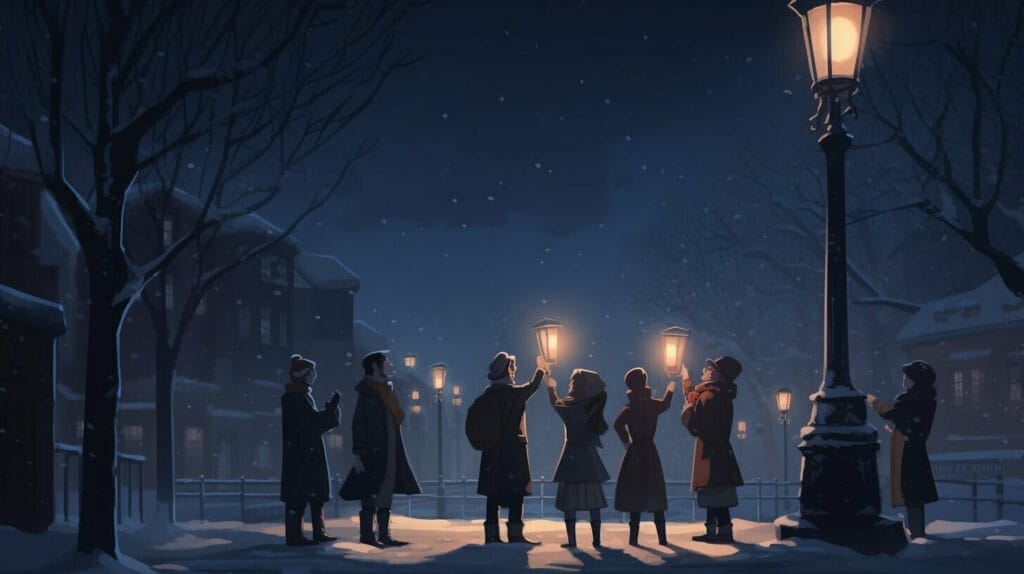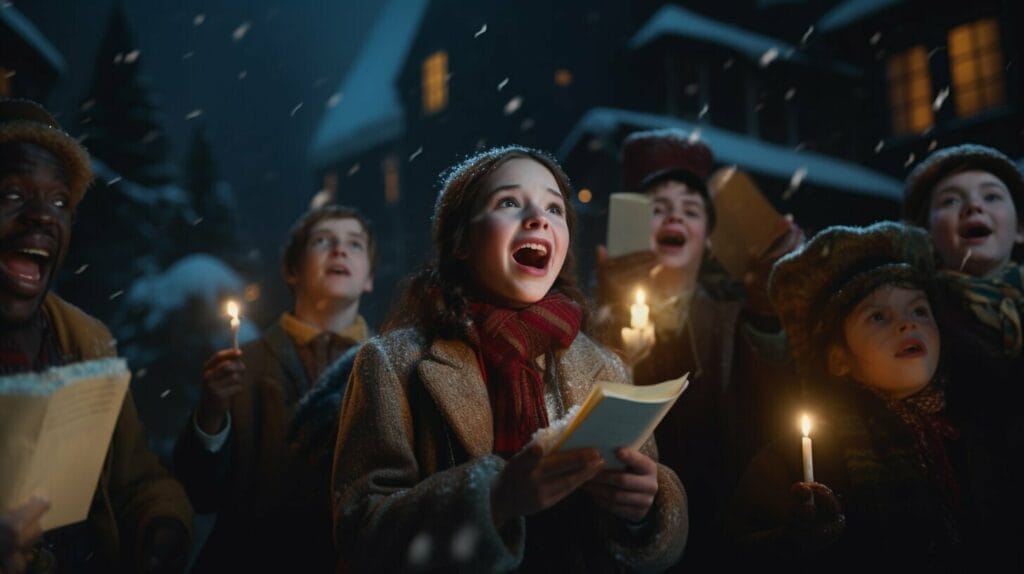Winter’s Favorite Soundtrack – The Story of Christmas Caroling

It’s that time of the year when the air is crisp and the streets are adorned with twinkling lights. The holiday season is upon us, and with it comes one of the most beloved traditions of all – Christmas Caroling. Whether you grew up singing classic hymns door to door or have only seen carolers in movies, there’s no denying the joy and warmth that this tradition brings.
But where did this tradition come from? And what exactly is the significance of Christmas Caroling? In this article, we’ll explore the rich history of this beloved tradition, from its origins to its modern-day practices. So, grab a cup of hot cocoa and let’s dive in!
- Christmas Caroling is a joyful tradition that has been around for centuries and continues to spread cheer during the holiday season.
- The roots of Christmas traditions, including Caroling, can be traced back to pagan customs.
- Caroling has religious significance, as it celebrates the birth of Jesus and is intertwined with church services.
- The history of Christmas Caroling includes its origins in wassailing and its resurgence during the Victorian era.
- Modern-day Caroling continues to keep the tradition alive, while also adapting to new practices and settings.
Embracing Christmas Traditions
As the holiday season approaches, it’s time to embrace the many Christmas traditions that have been passed down over generations. From hanging stockings by the fireplace to baking festive treats, these customs have become an essential part of our holiday celebrations.
But have you ever wondered about the origins of these traditions? Many of them have roots in pagan customs that predate Christianity, such as decorating evergreen trees and exchanging gifts. Even the date of Christmas, December 25th, was chosen to coincide with the pagan celebration of the winter solstice.
Over time, these customs evolved and became intertwined with the Christian faith. Caroling, for example, began as a religious expression of joy and celebration for the birth of Jesus. Today, it’s a joyful tradition that brings people together and spreads holiday cheer.
Despite their varying origins, these Christmas traditions have become a beloved part of the holiday season all around the world. Whether you’re hanging mistletoe or sipping eggnog, these customs help us celebrate the joy of the season and connect with loved ones.
So, as you gather with family and friends to embrace the holiday customs we all hold dear, take a moment to appreciate the rich history behind these traditions. Whether you’re continuing long-standing family rituals or creating new ones, the essence of the season remains the same – spreading joy and love to all.
“Christmas is not a time nor a season, but a state of mind. To cherish peace and goodwill, to be plenteous in mercy, is to have the real spirit of Christmas.” – Calvin Coolidge
The Birth of Caroling: From Religious Significance to Joyful Hymns
Christmas Caroling has its roots in the celebration of the birth of Jesus and the Nativity story. It is believed that the first Christmas carols were sung by angels to proclaim the joyous news of Christ’s birth to the shepherds in the fields. Over time, the tradition of singing hymns during Church services began to take shape, with Christmas carols becoming an integral part of the service.
In a quaint village in France, the echoes of a song dance in the air, giving birth to the word “carol”, derived from “carole”, a spirited circle dance accompanied by song. Imagine a time when the faithful would gather, hand in hand, encircling the humble Nativity, voices rising in harmony.

As the winds of winter carried these melodies across the seas, the magic of Christmas caroling touched every corner of Europe. England, with its rich tapestry of history, boasts carols from the 15th century, echoing tales of faith and devotion within church walls.
Like stories passed through generations, the tradition of caroling evolved, weaving its way into the hearts of diverse cultures. Today, from snowy streets to sun-kissed avenues, the world hums with the tunes of Christmas carols, uniting us in jubilation.
Caroling is more than just song; it’s the echo of joy, a celebration of Christ’s birth, and a chance to sprinkle festive cheer. So, as the snowflakes fall and bells jingle, gather your loved ones. Sing a carol, share a memory, and let the warmth of the season envelop you.
From Wassailing to Victorian Carolers
The history of Christmas Caroling dates back to medieval times when people would engage in a custom called wassailing. A group of people would go from house to house, blessing orchards and spreading good cheer. During the English Civil War and Oliver Cromwell’s rule, Christmas celebrations were banned in England. This included Christmas caroling, which was seen as a form of rebellion. However, the tradition of wassailing continued among the common people.
It was not until the Victorian era that Christmas caroling as we know it today became popular. The Victorians romanticized the idea of caroling and saw it as a way to bring together communities and spread joy during the holiday season. They modified the traditional wassailing songs and created new ones, with lyrics that celebrated the holiday spirit and the joys of winter.

The Victorian era saw the rise in popularity of Christmas caroling, with carolers dressed in period costumes bringing joy to communities.
The popularity of Christmas caroling continued to grow, and it became a beloved holiday tradition. Today, caroling is an important part of Christmas celebrations in many parts of the world, and it brings together people of all ages and backgrounds.
The Joy of Spreading Good Tidings
Christmas Caroling has always played an essential role in spreading joy and goodwill during the holiday season, and the tradition goes back centuries. In the Middle Ages, Anglo-Saxon peasants would go from home to home, singing for their supper, and the practice was later embraced by charities and churches. Today, Christmas Caroling is still an integral part of the holiday season and continues to foster a sense of charity and community.
In churches, Christmas Caroling is often associated with charity events where donations are collected for those in need. The practice of singing for charity dates back to the medieval era when wealthy patrons would provide food, shelter, and clothing to the poor during the long winter months. The tradition has continued to this day, and many churches organize caroling events to raise funds for local charities, providing a sense of goodwill and community spirit that is essential during the holiday season.

The tradition of singing for supper also had a significant impact on Christmas Caroling’s evolution. Anglo-Saxon peasants would sing for their supper and be rewarded with food and drink for their efforts. This practice has evolved over time, and today many Christmas Caroling events are accompanied by hot beverages like cocoa or the traditional wassail beverage, which is made of hot mulled cider, sugar, and spices. This drink is still enjoyed at caroling gatherings, fostering a sense of warmth and camaraderie.
Overall, Christmas Caroling is a tradition deeply rooted in spreading joy and goodwill, and it continues to hold a special place in both religious and secular celebrations. Whether you’re singing with a church group or going door-to-door with friends, the tradition of Christmas Caroling is a wonderful way to celebrate the season and spread a little bit of joy to those around you.
Christmas Caroling is a timeless tradition that has been passed down from generation to generation. Today, it continues to be an essential part of the holiday season, bringing joy and cheer to communities around the world.
During the winter solstice, carolers often gather on front porches to sing their favorite holiday tunes. This intimate setting creates a warm and welcoming atmosphere, making it the perfect opportunity to spread some holiday cheer with your neighbors.
One of the most significant aspects of Christmas Caroling is the oral tradition. It allows the tradition to be passed down through the ages, with each new generation adding their unique touch to the timeless classics. Whether it’s singing “Silent Night” or “Jingle Bells,” the melodies and lyrics have remained the same, creating a sense of unity and connectedness among carolers.

Another way to keep the tradition alive is by enjoying the traditional wassail beverage during caroling gatherings. This spiced cider is a staple during the holiday season, and it’s the perfect way to warm up on a chilly winter night.
In today’s modern world, organized caroling events are becoming increasingly popular. These events often take place in public spaces, providing an opportunity for everyone to come together and celebrate the holiday season. Whether you’re singing in a group or by yourself, the joy and spirit of Christmas Caroling are always present.
In conclusion, Christmas Caroling is a tradition that has stood the test of time. Whether you’re singing on a front porch or at an organized event, the joy and goodwill that it spreads remain the same. So, get out there, spread some holiday cheer, and keep this timeless tradition alive for generations to come.
FAQ
What is Christmas Caroling?
Christmas Caroling is a tradition where groups of people sing Christmas songs together, spreading joy and holiday spirit.
How did Christmas Caroling originate?
Christmas Caroling has its roots in ancient pagan customs and evolved over time to become a Christian tradition associated with the celebration of the birth of Jesus.
What is the significance of Christmas Caroling?
Christmas Caroling is a way to celebrate the joy of Christmas, share goodwill, and bring people together during the holiday season.
Was Christmas Caroling always a religious tradition?
While Christmas Caroling has deep religious origins, it has also been embraced by non-religious communities as a way to enjoy and celebrate the festive season.
How has Christmas Caroling evolved over time?
Christmas Caroling has evolved from its early origins as wassailing to a more organized and widespread tradition, with variations in songs, styles, and settings.
Is Christmas Caroling still popular today?
Yes, Christmas Caroling continues to be a beloved tradition, with many communities organizing caroling events and individuals gathering to sing songs during the holiday season.




